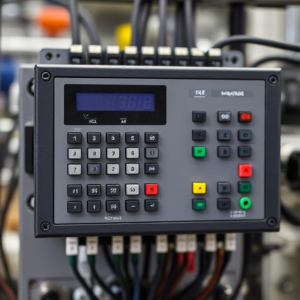A Programmable Logic Controller (PLC) is a special type of computer used to control machines and processes in industrial automation. It’s like the brain of an automated system, helping machines like conveyor belts, pumps, or motors to operate automatically based on the given instructions.

Key Points about PLCs:
- What It Does:
- A PLC controls machines and equipment by sending electrical signals based on a set of programmed instructions. It receives input signals from sensors, processes them, and sends output signals to control actuators (like motors, valves, etc.).
- Why It’s Used:
- In industries like manufacturing, packaging, and power plants, PLCs are used to automate processes that would otherwise require a lot of manual labor. This improves speed, consistency, and safety while reducing human errors.
- How It Works:
- Inputs: PLCs receive data from various devices such as buttons, sensors, or switches. These are the inputs (e.g., temperature sensors or limit switches).
- Processing: The PLC’s central unit processes the inputs using a program written by engineers or operators. The program is created using a specific language (usually ladder logic, which looks like electrical circuits).
- Outputs: Based on the inputs and the program, the PLC sends commands to outputs like motors, lights, or actuators to perform specific tasks.
- PLC Components:
- CPU (Central Processing Unit): This is the brain of the PLC. It processes all the instructions and controls how the system operates.
- Input/Output Modules: These allow the PLC to connect to the outside world, including sensors (input) and actuators (output).
- Power Supply: Provides the necessary electrical power for the PLC to operate.
- Programming Device: A computer or terminal used to write and upload the program into the PLC.
- Programming:
- PLCs are programmed using special languages, the most common of which is ladder logic. This language resembles electrical relay diagrams and is easy for engineers to understand.
- Other programming languages include structured text, functional block diagrams, and instruction lists.
- Advantages of PLCs:
- Reliability: PLCs are built to work continuously in harsh industrial environments, with high levels of reliability.
- Flexibility: They can be reprogrammed easily to handle different tasks.
- Scalability: You can add more modules or expand the PLC system as the needs of the process grow.
- Automation: PLCs reduce human intervention, making processes faster, safer, and more consistent.
- Examples of Applications:
- Conveyor Belts: PLCs can control the movement of belts, making sure items are moved from one part of the factory to another without human intervention.
- Water Treatment: PLCs can control pumps, valves, and tanks to ensure water is filtered and treated according to specific parameters.
- Assembly Lines: PLCs can automate the steps in a manufacturing line, from assembling parts to packaging finished products.
Conclusion:
A PLC is like a super-efficient, rugged, and programmable controller for industrial systems. It can take inputs from sensors, make decisions based on a program, and control outputs to ensure machines and processes operate automatically and efficiently. It helps in reducing manual work, improving safety, and increasing production efficiency in many industries.
Tags: Actuators, assembly line automation, Automation, central processing unit, control programming, Control Systems, conveyor belts, CPU, electrical signals, flexibility, functional block diagrams, harsh environments, industrial automation, industrial machinery, industrial processes., Input Signals, input/output modules, instruction lists, ladder logic, machine control, manufacturing automation, motors, output signals, packaging automation, PLC, PLC applications., PLCs, Power Supply, process control, production efficiency, programmable controller, Programmable Logic Controller, programming device, reducing manual labor, reliability, reprogramming, safety improvement, Scalability, Sensors, structured text, valves, water treatment control


